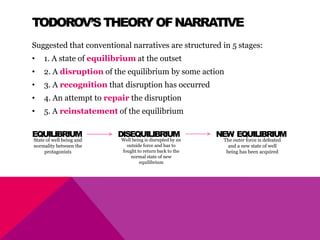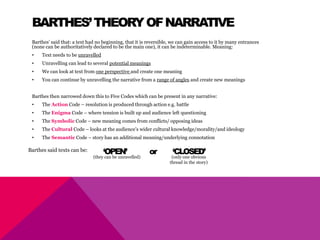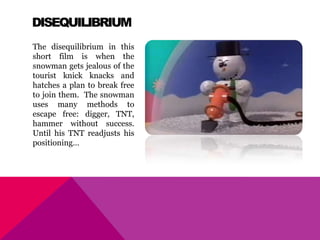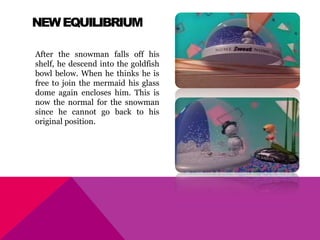Narrative Theories and Examples
- 2. TODOROV’S THEORY OF NARRATIVESuggested that conventional narratives are structured in 5 stages:1. A state of equilibrium at the outset
- 3. 2. A disruption of the equilibrium by some action
- 4. 3. A recognition that disruption has occurred
- 5. 4. An attempt to repair the disruption
- 6. 5. A reinstatement of the equilibrium EQUILIBRIUMDISEQUILIBRIUMNEW EQUILIBRIUMState of well being and normality between the protagonists Well being is disrupted by an outside force and has to fought to return back to the normal state of new equilibrium The outer force is defeated and a new state of well being has been acquired
- 7. Barthes’ THEORY OF NARRATIVEBarthes’ said that: a text had no beginning, that it is reversible, we can gain access to it by many entrances (none can be authoritatively declared to be the main one), it can be indeterminable. Meaning:Text needs to be unravelled
- 8. Unravelling can lead to several potential meanings
- 9. We can look at text from one perspective and create one meaning
- 10. You can continue by unravelling the narrative from a range of angles and create new meaningsBarthes then narrowed down this to Five Codes which can be present in any narrative:The Action Code – resolution is produced through action e.g. battle
- 11. The Enigma Code – where tension is built up and audience left questioning
- 12. The Symbolic Code – new meaning comes from conflicts/ opposing ideas
- 13. The Cultural Code – looks at the audience’s wider cultural knowledge/morality/and ideology
- 14. The Semantic Code – story has an additional meaning/underlying connotationBarthes said texts can be:‘OPEN’ or ‘CLOSED’(they can be unravelled)(only one obvious thread in the story)
- 15. Straus’s THEORY OF NARRATIVE Straus suggested the theory of ‘binary opposites’, where two qualities or subjects are direct opposites of each other. Essentially one thing can only be defined where its opposite is also present. This theory helps reveal the underlying themes and symbolism in many media texts: Examples of binary opposites:Good vs. Evil
- 16. Hero vs. Villain
- 19. Inside society vs. Outside societypropp’S THEORY OF NARRATIVESuggested that characters took the role of narrative “spheres of action” or a function. Stating 7 main character types:1. The hero (seeks something)
- 20. 2. The villain (opposes the hero)
- 21. 3. The donor (provides an object to the hero)
- 22. 4. The helper (aids hero in his quest)
- 23. 5. The princess (reward for hero and requires protection from the villain)
- 24. 6. The dispatcher (sends the hero on a task)
- 25. 7.The false hero (appears to be good but reveals he is bad)PIXAR: KNICK KNACK Knick Knack is a short film made by Pixar in 1989. It tells the story of the snowman who has spent his life on a shelf in his glass house; opposite him are more free living tourist ‘knick knacks. The story shows the snowman’s effort to release him free of his isolated house to join the others. However in the end, he pushes himself free off the shelf but lands in a fish tank and then thinks he is free to join the mermaid who lives in there too. But his glass house follows shortly after him and once again is encased in his house without any means of escape.
- 26. equilibrium The equilibrium at the beginning of the story is the snowman living in his glass dome. It is apparent at the beginning of the short film that the norm for the snowman is to be isolated in his glass house.
- 27. disequilibrium The disequilibrium in this short film is when the snowman gets jealous of the tourist knick knacks and hatches a plan to break free to join them. The snowman uses many methods to escape free: digger, TNT, hammer without success. Until his TNT readjusts his positioning…
- 28. New equilibrium After the snowman falls off his shelf, he descend into the goldfish bowl below. When he thinks he is free to join the mermaid his glass dome again encloses him. This is now the normal for the snowman since he cannot go back to his original position.
- 29. Tries to save himself from isolationEncourages the snowman to join herTHE HEROTHE SNOWMANTHE TOURIST BARBIETHE PRINCESS









